Lamborghini NINFA 24 MCS Boiler: Maintenance, Tips, and Accessories
The Lamborghini NINFA 24 MCS sealed boiler is a boiler in which balanced combustion is achieved through a fume fan, also known as an extractor. It has lower energy efficiency compared to a condensing boiler, however, all combustion is controlled inside an enclosure called the combustion chamber.
In fact, traditional boilers cannot exploit all sensible heat to avoid corrosion from condensation. The water vapor generated by the combustion process is then released into the atmosphere through the chimney, along with the associated latent heat.
Annual Boiler Maintenance
Annual maintenance is indispensable to preserve the safety, efficiency, and reliability qualities of your device. This annual intervention prevents malfunctions and ensures the continuous safety of the system.
Winter Boiler Maintenance: Complete Guide
- Pressure Check: Ensure that your Lamborghini NINFA 24 MCS boiler’s pressure gauge shows adequate pressure.
- Thermostat Maintenance: Regularly check the thermostat batteries to avoid malfunctions during the colder months.
- Heating System Pressure: Check that the pressure is maintained between 1 and 1.5 bar for optimal operation.
- Professional Support: For thorough maintenance and cleaning of your Lamborghini NINFA 24 MCS boiler, always contact qualified personnel.
Maintaining Heating System Pressure
It’s essential to check the heating system’s pressure quarterly, ensuring it’s between 1bar and 2bar. This check should not be neglected even during the summer months, as the radiator water is used for hot water production. A drop in pressure can interrupt the boiler’s operation.
To adjust the pressure, use the filling tap under the appliance. Open it to bring the pressure to 1.5bar, then close it.
Suggested Temperatures
The Lamborghini NINFA 24 MCS boiler can always produce the temperature you want for heating according to your needs. You can adjust the temperatures via the control panel, but we suggest setting the hot water temperature (DHW) to the minimum necessary due to limescale and domestic hot water (DHW) considerations.
Attention to temperature settings:
- The heating temperature setting refers to the radiator temperature, not the ambient temperature.
- The domestic hot water temperature setting should be kept as low as possible to avoid calcification inside the secondary heat exchanger.
DIY: Replacement of Shower Filters and Heads
Discover how to easily replace the aerator filters and shower heads in your shower to prevent limescale buildup. This simple maintenance can avoid overheating problems and difficulties in removing filters, ensuring the proper functioning of the Lamborghini NINFA 24 MCS boiler.
[display-posts tag=”prodotti-consigliati-amazon” include_title=”true” include_thumbnail=”true” image_size=”thumbnail” posts_per_page=”4″ wrapper=”div” wrapper_class=”carousel-container” wrapper_id=”carousel-unique” content_class=”dps-listing-content”]
Boiler Settings for the Holidays
Before going on vacation, it is important to take some measures to ensure the safety of your Lamborghini NINFA 24 MCS boiler. Even the most modern models can have problems if left inactive for an extended period.
Recommended steps:
- Close the water valve to avoid leaks during your absence.
- Disconnect the gas supply as an additional safety measure.
- Turn off the heat generator to conserve energy and improve safety.
When you return, reactivate these settings in reverse order. You may need to reset the heat generator to correct any errors.
These simple steps will ensure a worry-free vacation, knowing that your boiler is safe.
Boiler Usage Warnings
To ensure the safety, efficiency, and performance of the NINFA 24 MCS appliance, annual maintenance is crucial. It is highly discouraged to intervene inside the boiler without adequate technical skills. In case of anomalies or malfunctions, it is important to always consult a qualified technician. Annual maintenance by specialized personnel is essential for the safety and continuous functioning of the appliance.
Regarding the Use of Electric Energy
- Do not touch the appliance with wet or damp parts, or while barefoot
- Do not pull on electrical cords
- Do not expose the appliance to atmospheric agents such as rain, sun, etc., unless expressly provided for.
- In case of damage to the cord, turn off the appliance and consult exclusively professionally qualified personnel for its replacement.
Safety Actions in Case of Gas Detection
If a gas odor is detected, it is fundamental to adopt these precautionary measures:
- Do not use electrical appliances, including phones, that might generate sparks.
- Immediately open doors and windows to facilitate air exchange.
- Stop the gas supply by closing the taps.
- Immediately request the intervention of a specialized technician.
It is important to use the NINFA 24 MCS boiler exclusively for the purposes for which it is designed, avoiding improper uses that can be dangerous. Ensure that any intervention on the boiler is carried out by qualified personnel to prevent accidents and maintain the warranty.
Index of Components and Spare Parts
Use this section as an index to navigate through the different components and spare parts of the NINFA 24 MCS boiler. You will find clear descriptions and practical advice for each part, which will help you manage the maintenance of your appliance in the best possible way.
Display of the NINFA 24 MCS Boiler
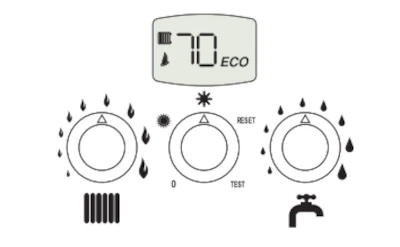
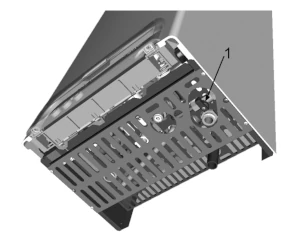
Boiler Filling Tap of NINFA 24 MCS
The filling tap is an essential component for maintaining optimal pressure inside the NINFA 24 MCS boiler. This tap, usually located at the bottom of the boiler (as shown in the image), should be opened when the system’s pressure drops below 1 bar.
To refill the system, slowly open the tap until the pressure reaches the recommended level, usually around 1.5 bar. It is crucial to remember to close the tap after refilling to avoid overpressure that could damage the boiler or the system.
Quick Solutions for Errors
- Error A01: Encountered a flame lock? No problem, just press the Reset button for an easy reset. If it persists, our support team is ready to help you.
- Error F37: Low water pressure? Simply adjust the filling tap to reach the optimal pressure of 1.5 bar. You’ll see error F37 transform into FH on the display, a sign of a perfect reset.
- FH: When you see FH on the display, your boiler is simply eliminating excess air. A brief two-minute process to always ensure the best operation.
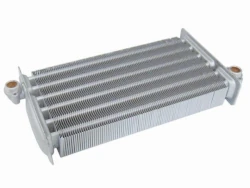
Functionality of the Primary Heat Exchanger
The copper primary heat exchanger of the Lamborghini NINFA 24 MCS boiler plays a vital role in the thermal efficiency of the system. Thanks to its breadth, it guarantees excellent heat exchange.
The overtemperature sensor is positioned to detect and prevent overheating risks, avoiding issues like internal boiling.
Blockages in the pipes can cause problems with this component, leading to noise and reduced water flow. Preventive maintenance, including the installation of a Magnetic Filter, can help reduce such risks.
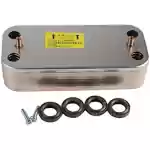
Efficiency of the Plate Heat Exchanger
The plate heat exchanger in the Lamborghini NINFA 24 MCS boiler is designed to ensure optimal heating of domestic hot water. The innovative design allows for efficient thermal exchange between the water from the heating circuit and the water supply. Although these exchangers are designed to withstand flow variations, they can accumulate limescale over time, which can decrease the effectiveness of water heating. For this reason, we recommend regularly monitoring the state of the exchanger and proceeding with its replacement when necessary. The use of a polyphosphate doser and maintaining low temperatures for hot water are effective preventive measures against limescale formation, thus ensuring the long life and efficiency of the plate exchanger in your Lamborghini NINFA 24 MCS boiler.
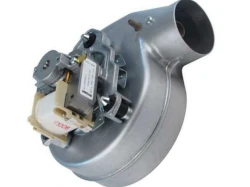
Fume Extractor
In the boiler Lamborghini NINFA 24 MCS, the fume extractor may experience problems such as centrifuge blockages or unusual noises due to friction or deformations. These signs should not be ignored, as they can lead to greater inefficiencies or dangers. Addressing these issues requires professional technical inspection, including cleaning and checking of critical components such as the air pressure switch and the centrifuge.
Paying special attention to these symptoms can prevent serious faults, keeping the boiler Lamborghini NINFA 24 MCS in optimal condition.
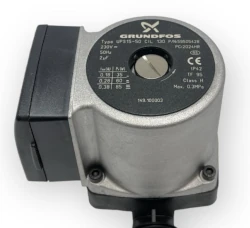
Grundfos UPS15/60 Pump
The Grundfos UPS15/60 pump is a key component for efficient water circulation in the NINFA 24 MCS boiler. It offers three different speeds, but the use of the third speed (maximum) is recommended to optimize performance, unless there are noises related to water circulation that suggest a lower speed.
The pump is generally easy to replace by an expert technician, but it is important to note that after years of operation, the stator may become stuck to the cast iron head, making unlocking difficult in extreme cases.
The main technical features of the UPS15/60 model include:
- 2.5 μF 230V – 50Hz IP44 TF 95
- Speed III: A 0.38 – W 85
- Speed II: A 0.30 – W 65
- Speed I: A 0.21 – W 45
This pump is also suitable for replacing UPS motors 15-50, 15-60, 25-50, 25-60, 15-65, 25-65.
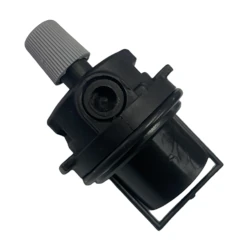
Automatic Plastic Air Purger
The plastic automatic air purger, used as an insert in the purging housing in the pump manifold, is a key component in the Lamborghini NINFA 24 MCS boiler. This small element plays a vital role in ensuring the efficiency of the heating system by eliminating air from the system.
Made of durable plastic, this air purger is designed to easily fit into the dedicated housing in the pump manifold. Its use is particularly recommended to prevent air accumulation in the boiler’s hydraulic circuitry, especially in systems with a lot of aluminum where this problem is more frequent after periods of inactivity (summer).
Regularly checking and replacing the air purger and the system pressure is essential for maintaining uninterrupted operation at the start of the heating season. Its functionality is crucial for the proper operation of the entire domestic heating system.
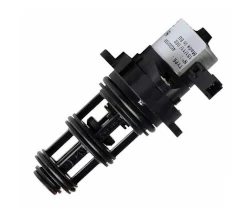
Ferroli Component: Insert for Diverter Valve
The insert for the diverter valve, also known as the diverter valve motor, is essential for the proper functioning of boilers. This component is responsible for directing heat from the primary exchanger to the heating system or sanitary water.
Easy to install, the insert includes a motor with a power connector, fitting perfectly inside the boiler’s diverter valve. Its role is crucial for efficiently managing the passage of heat between the various circuits.
A common problem with this component is motor breakdown, which can cause a malfunction of the system, limiting heating to only sanitary water or only the heating system.
Safety Systems according to the ErP Directive
The construction and installation of boilers in Europe are strictly regulated by a series of European standards, aimed at ensuring safety, energy efficiency, and reduction of environmental impact.
One of the main reference regulations is the ErP (Energy-related Products) Directive, which imposes stringent requirements in terms of energy efficiency and emissions for all energy-related products, including boilers. This directive is accompanied by specific UNI EN standards for each type of boiler, detailing the technical and safety standards to be respected.
The NINFA 24 MCS boiler therefore includes:
The Safety Thermostat, located on the heating supply, intervenes by blocking the gas flow to the burner in case of overheating of the water in the primary circuit. It is essential to never deactivate this safety device.
The Flame Ionization Detector ensures safety by shutting down the boiler in case of gas absence or incomplete ignition of the main burner.
The Antifreeze Device activates the burner to maintain the water temperature above 5 °C, preventing freezing of the system.
The Hydraulic Safety Valve, set at 3 bar, protects the heating circuit. It is advisable to connect it to a siphoned drain and not use it to empty the circuit.
Boiler Errors and Anomalies NINFA 24 MCS
The control board of the Lamborghini NINFA 24 MCS boiler is always capable of detecting anomalies. These anomalies can be blocking or non-blocking, and some may require a reset procedure. Below is a list of anomalies that may occur in the NINFA 24 MCS boiler.
Boiler Errors and Anomalies NINFA 24 MCS
| Fault Code | Anomaly Code | Anomaly Description | Anomaly Type |
|---|---|---|---|
| 01 | A01 | Missing Flame | Block |
| 02 | A02 | Flame Signal Present with Burner Off | Block |
| 03 | A03 | Overtemperature Protection Intervention | Block |
| 05 | F05 | Smoke Anomaly | Anomaly |
| 06 | A06 | Flame Loss After Ignition Phase (5 times in 4 min.) | Block |
| 10 | F10 | Supply Sensor Anomaly | Anomaly |
| 11 | F11 | Sanitary Sensor Anomaly | Anomaly |
| 14 | F14 | Safety Sensor Anomaly | Anomaly |
| 34 | F34 | Supply Tension Anomaly | Anomaly |
| 35 | F35 | Network Frequency Anomaly | Anomaly |
| 37 | F37 | Insufficient Water Pressure in the System | Anomaly |
| 39 | F39 | External Probe Anomaly | Anomaly |
| 41 | A41 | Protection for Disconnected Sensor | Block |
| 42 | F42 | Protection for Difference in Supply Sensors | Anomaly |
| 43 | F43 | Exchanger Protection | Anomaly |
| 50 | F50 | Modureg Disconnected | Anomaly |
Anomaly 1: Lack of Flame
In each attempt to ignite the burner, the fan and the smoke pressure switch are activated. After the pressure switch changes, the first ignition attempt is made with the gas valve and transformer active for 5 seconds and the modulation current set to 50%. If no flame is detected, the flame control waits 10 seconds before trying again. After three unsuccessful attempts, anomaly 1 is generated, leading to the boiler’s lockout. With LPG, there is only one ignition attempt.
Anomaly 2: Parasitic Flame
This anomaly occurs if, with the burner off, the system detects an ionization current, indicating the presence of a parasitic flame. In this case, the flame control locks.
Anomaly 3: Overtemperature Protection of Supply
There are various scenarios for this anomaly. In the absence of ignition, exceeding 105°C does not generate anomalies. If the burner turns off due to high temperature, a 10-second timer is activated. If the sensor exceeds 105°C in this period, it results in a lockout. Additionally, if at ignition the sensor is above 105°C and does not drop below 100°C within 60 seconds, a lockout occurs. Finally, if the sensor reaches 105°C during ignition, this leads to an immediate lockout.
Anomaly 5: Smoke Anomaly
In each ignition attempt, the fan is powered, and the Air Pressure Sensor must reach a predetermined value. If this does not happen within 25 seconds, an anomaly occurs. During this condition, no operation requests can be satisfied. The protection is deactivated as soon as the Air Pressure Sensor returns to normal values.
Anomaly 6: Flame Lost 5 Times in 4 Minutes
If the burner is on and suddenly the flame signal disappears, and this condition occurs 5 times in 4 minutes, the flame control generates anomaly 6 and locks the system. A reset is necessary to restore functionality.
Anomaly 10: Faulty Heating NTC Sensor
A failure of one of the NTC sensors in the dual supply sensor (short circuit or open circuit) deactivates the burner ignition commands. No operation requests can be satisfied until the fault is resolved.
Anomaly 11: Faulty Sanitary NTC Sensor
The failure of the sanitary NTC sensor (short circuit or open circuit) causes the deactivation of the burner ignition commands in sanitary mode. The protection is deactivated upon resolving the fault.
Anomaly 14: Faulty Safety NTC Sensor
The failure of one of the NTC sensors in the dual supply sensor (short circuit or open circuit) causes the deactivation of the burner ignition commands. No operation requests can be satisfied until the fault is resolved.
Anomaly 34: Mains Voltage Below 180Vac
When the mains voltage falls below 180Vac, anomaly 34 is activated. The boiler continues to operate down to a minimum of about 170Vac. The anomaly is resolved when the voltage exceeds 185Vac.
Anomaly 35: Abnormal Mains Frequency
The board detects an incongruence between the programmed mains frequency (50Hz or 60Hz) and the actual one, activating anomaly 35. Resolution is achieved by modifying the parameter related to the frequency.
Anomaly 37: Insufficient System Pressure
If the system pressure falls below the minimum value (0.4 bar by default), the burner shuts off and the pump stops. Resolution is achieved by increasing the pressure to the nominal value (0.8 bar by default) plus 0.2 bar. After resolution, the FH Mode is automatically activated.
Anomaly 39: Faulty External NTC Sensor
A failure (short circuit or open circuit) in the external NTC sensor does not deactivate the burner ignition commands. If the system was operating in Sliding Temperature mode, modulation will be adjusted to the user’s set heating setpoint. The anomaly is deactivated upon resolving the fault.
Anomaly 41: Protection for Disconnected Sensor
In each ignition attempt, the system activates a 15-second timer after opening the gas valve. If the temperature read by the supply sensor varies by ±1°C, the sequence continues; otherwise, after 10 seconds, a new attempt begins. After three attempts without temperature variation, the burner shuts off, and the flame control locks. The pump continues to operate for the post-circulation time specified.
Anomaly 42: Protection for Difference in Supply Sensors
This protection activates when the two supply sensors show a temperature difference greater than 12°C. In this case, the burner ignition commands are deactivated. The protection deactivates when the difference falls below 10°C.
Anomaly 43: Heat Exchanger Protection
If the increase in temperature detected by the heating sensor exceeds 6°C/second, this anomaly is activated. This results in the deactivation of the burner ignition commands. The anomaly automatically resets when the temperature drops below 40°C.
Anomaly 50: Modureg Disconnected
This anomaly occurs in case of contact opening of the Modureg during the operation of the boiler. The anomaly is activated immediately and is resolved as soon as the fault is repaired.
Possible Improvement Works
The Lamborghini NINFA 24 MCS boiler requires special attention to the proper cleaning of the flue pipe. Especially at the bends leading to the vertical section, dirt can accumulate, compromising the functionality of the smoke fan. It is essential to have a qualified technician ensure that the pipes are in optimal condition.
Integrating a Gas Tap with a Test Well
Not always does the meter provide a connection for instrumental tightness testing. A useful tip is to replace the gas tap under the boiler with a valve with a well equipped with an instrumental take-off, essential for the tightness test of the system. This element can be crucial in case of inspections and safety checks and certainly facilitates the maintenance of the NINFA 24 MCS boiler.
In fact, during the maintenance of the appliance, it is mandatory to perform a suitable test like UNI 11137:2019 that verifies the correct tightness of the gas system.
Flushing the Heating System
Flushing the heating system is crucial to prevent clogging of the primary exchanger of the Lamborghini NINFA 24 MCS boiler. Over time, especially in cast iron or aluminum systems, a metallic sludge can form that can clog the narrow passages of the exchanger.
After flushing the system, it is highly recommended to install a magnetic sludge filter on the Lamborghini NINFA 24 MCS boiler. This filter plays an essential role in protecting the exchanger from the buildup of dirt and debris, ensuring greater efficiency and longevity of the heating system.
Additional improvements can include the installation of an advanced thermostat with relay function. This device allows for more effective management of heating hours, helping to optimize energy consumption.
Suggested Accessories
To optimize the functionality and efficiency of your NINFA 24 MCS boiler, there are various accessories that we recommend considering:
- Programmable Thermostat: Regulates ambient temperature on a daily or weekly basis. The advanced new generation models also offer remote control and advanced programming.
- Magnetic Filter Dirt Separator: An essential device for keeping the hydraulic circuit clean, removing both magnetic and non-magnetic impurities and debris.
Magnetic Filter for Heating
Considered the best accessory to block the entry of dust and debris from the heating system into the device.
The magnetic filter should be applied on the heating return line to the boiler, separating everything that could clog the boiler and cause temperature increases in the primary exchanger. The diverter valve is also less stressed, and the adoption of the magnetic filter could prevent its leakage.
Polyphosphate Dosing Pump
If the hardness of the tap water exceeds 20 French degrees, we suggest equipping the boiler with a polyphosphate doser.
This powder or liquid additive is proportionally mixed with the cold water entering the boiler and decreases the formation of limescale inside the device. Polyphosphates need to be replenished whenever they run out.
There are various models, but the most common ones are:
- Powder Polyphosphates
- Liquid Polyphosphates
Clearly, the type of polyphosphate requires a suitable mechanism for mixing.
[display-posts tag=”dosatori-polifosfati-amazon” include_title=”true” include_thumbnail=”true” image_size=”thumbnail” posts_per_page=”4″ wrapper=”div” wrapper_class=”carousel-container” wrapper_id=”carousel-unique” content_class=”dps-listing-content”]
Integrated Solutions: Thermostat and Programmable Thermostat
For advanced and integrated control of the Lamborghini NINFA 24 MCS boiler, choose a latest generation room thermostat or programmable thermostat.
These devices offer sophisticated home temperature regulation, perfectly adapting to your lifestyle and needs. With programmable thermostats, you can easily set custom schedules for each day of the week, ensuring a consistently comfortable environment and optimizing energy consumption.
Select from a variety of models, including:
- Daily Programmable Thermostats
- Weekly Programmable Thermostats
- Connected Thermostats for Remote Control
Your choice should complement the specifics of your Lamborghini NINFA 24 MCS boiler and your home.
Daily Programmable Thermostat
The daily programmable thermostat is an effective solution for daily temperature control in your home.
This device allows you to set the desired temperature for each individual day, enabling flexible management adaptable to your daily routines. It is ideal for those seeking simple yet precise control of home heating, with the ability to adjust settings according to variations in their daily schedule.
Typical features of a daily programmable thermostat include:
- Easy and intuitive programming
- Precise temperature adjustment
- Energy-saving functions
This type of thermostat is an optimal choice for those who want to combine comfort and energy efficiency without the need for complex weekly programming.
[display-posts tag=”dosatori-polifosfati-amazon” include_title=”true” include_thumbnail=”true” image_size=”thumbnail” posts_per_page=”4″ wrapper=”div” wrapper_class=”carousel-container” wrapper_id=”carousel-unique” content_class=”dps-listing-content”]
Weekly Programmable Thermostat
For advanced and personalized home temperature management, the weekly programmable thermostat is an excellent choice.
This device allows for setting different temperatures for various days of the week, perfectly adapting to different weekly routines. It is ideal for those who need detailed heating control, with the ability to set lower temperatures on days when the home is empty and higher when it is occupied.
Key features of the weekly programmable thermostat include:
- Flexible programming for each day of the week
- Advanced energy-saving functions
- Intuitive user interface for easy programming
A weekly programmable thermostat is perfect for those seeking a balance between comfort, convenience, and energy efficiency, providing precise control of the home climate.
[display-posts tag=”dosatori-polifosfati-amazon” include_title=”true” include_thumbnail=”true” image_size=”thumbnail” posts_per_page=”4″ wrapper=”div” wrapper_class=”carousel-container” wrapper_id=”carousel-unique” content_class=”dps-listing-content”]
Advanced New Generation Thermostats
New generation advanced thermostats offer cutting-edge technologies for optimal home climate control.
These devices stand out for their learning capability and adaptation to user habits, automatically adjusting the temperature based on daily and seasonal patterns. With features like remote control via smartphone and integration with home automation systems, they offer an unprecedented level of convenience and energy efficiency.
Salient features of these thermostats include:
- Wi-Fi connectivity and remote control
- Integration with voice assistants and smart home systems
- Learning algorithms for automatic temperature optimization
For those seeking the utmost efficiency, convenience, and personalization in home temperature control, an advanced new generation thermostat is the ideal choice.
[display-posts tag=”dosatori-polifosfati-amazon” include_title=”true” include_thumbnail=”true” image_size=”thumbnail” posts_per_page=”4″ wrapper=”div” wrapper_class=”carousel-container” wrapper_id=”carousel-unique” content_class=”dps-listing-content”]
Common Questions and Answers About the Boiler
Here is a list of common questions and answers that we frequently receive about the Lamborghini NINFA 24 MCS boiler model. This section will help you better understand the features, functionality, and maintenance of your appliance.
Hot Water takes forever to reach the shower/bathroom !!
The delay in hot water reaching the bathroom is often caused by a buildup of dirt in the aerator or showerhead holes. This buildup can reduce water flow, consequently slowing down the flow of hot water in the pipes. Cleaning these accessories from limescale can usually restore the speed of the hot water arrival.
Additionally, if the pipes connecting the bathroom to the boiler are made of iron, they might absorb some of the water’s heat, lengthening the time for hot water to arrive. The presence of iron pipes can thus affect the timing of hot water delivery to the bathroom.
What is the difference between COMFORT 1 and COMFORT 2?
The manufacturer offers two COMFORT functions for the NINFA 24 MCS boiler, activated through the ECO/COMFORT1/COMFORT2 button.
- Comfort 1: In this mode, you can adjust the domestic hot water temperature using the + and – buttons (near the faucet symbol).
- Comfort 2: In this mode, the temperature is fixed at 45°C without the possibility of adjustment.
Opentherm Protocol Support by the Boiler
YES: The boiler is pre-equipped for a tension-free connection with an Advanced Thermostat or Remote Control. The functionalities offered include:
- Control of domestic hot water temperature: Useful for NINFA 24 MCS boilers installed in less accessible locations.
- Adjustment of radiator temperature: An advanced Opentherm chronothermostat allows communication of the desired radiator temperatures to the boiler.
- Time scheduling for water heating: Beneficial for boilers with storage tanks, helping to reduce boiler maintenance costs, like gas.
- Error Resolution: Through Opentherm 2 or with devices from Lamborghini.
- etc…
Pressing the buttons to adjust the heating, the temperature does not change.
The button panel is sensitive to repeated presses after years of operation. Often, the malfunction of the adjustment buttons is due to the absence of a thermostat, which has led to the exclusive use of the boiler’s buttons.
In light of this, it is suggested to install a new control board to restore the correct functioning of the button panel, but also to integrate a thermostat to continue adjusting the heating from another, more reliable, and less expensive device.
